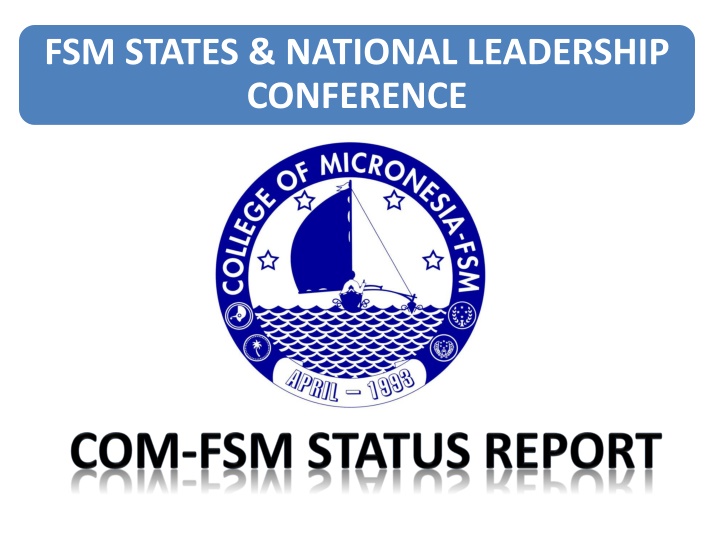
Leadership Conference Impact and Resource Efficiency
Explore the impact of Pell Grant changes, future implications, and strategies for resource efficiency in a leadership conference setting. The conference delves into enrollment impacts, potential future changes, and initiatives to enhance operational effectiveness.
Download Presentation

Please find below an Image/Link to download the presentation.
The content on the website is provided AS IS for your information and personal use only. It may not be sold, licensed, or shared on other websites without obtaining consent from the author. If you encounter any issues during the download, it is possible that the publisher has removed the file from their server.
You are allowed to download the files provided on this website for personal or commercial use, subject to the condition that they are used lawfully. All files are the property of their respective owners.
The content on the website is provided AS IS for your information and personal use only. It may not be sold, licensed, or shared on other websites without obtaining consent from the author.
E N D
Presentation Transcript
FSM STATES & NATIONAL LEADERSHIP CONFERENCE
PELL GRANT CHANGES AND IMPACT 1. Elimination of Year Round Pell Grant Elimination of Pell Grant for summer sessions Impact on enrollment Summer 2011 enrollment = 2108 Summer 2012 enrollment = 1275 40% reduction in summer enrollment
PELL GRANT CHANGES AND IMPACT 2. Reduction in Maximum Number of Semesters Reduction from 18 semesters to 12 semesters Impact on returning & new students Impact on students Currently: 66 enrolled BA/4th year students need other means of financial support
POTENTIAL FUTURE IMPACT The formula for eligibility will be moving away from enrollment/numbers to a weighted average of completion rates, persistence rates, and other measures of student and institutional performance. The current level of college readiness of students could have a serious impact on the college.
SHARED RESOURCES, ELIMINATED DUPLICATION, REDUCED COST, AND ACHIEVED EFFICIENCIES 1. Established of 5-Year Integrated Financial and Educational Master Plan 2. Completed Total Cost of College Ownership 3. Freeze salary step increases 4. Shared academic and administrative leadership for Yap Campus and FMI 5. Established common schedule
SHARED RESOURCES, ELIMINATED DUPLICATION, REDUCED COST, AND ACHIEVED EFFICIENCIES 6. Shared schedule, planning, faculty, staff, and administrative resources between Pohnpei Campus and National Campus 7. Implemented academic and non-academic program prioritization 8. Limited Travel (accreditation/essential business only) 9. Eliminated non-essential vehicles 10. Planned college-wide space utilization study
ACCREDITATION Synopsis of work on the COM-FSM Quality, Sustainability, and Success: A Framework for Planning and Action-Status Report provided Midterm and Follow Up Report Midterm is part of the normal 6-year accreditation cycle The Follow Up is required to address the four remaining recommendations Due 15 MARCH 2013 Student Learning Outcomes Report Brief, special report required of all ACCJC/WASC institutions Due 15 MARCH 2013
ACCREDITATION The American Council on Education (2012) reported U.S. institutions spend an average of $1million annually on accreditation. ACCJC/WASC President Beno noted standards and expectations will continue to rise in the coming years. (PPEC meeting, September 2012) . Significant interest around COM-FSM financial stability emerged at the ACCJC/WASC June 2012 hearing. American Council on Education. (2012). Assuring academic quality in the 21st century: Self-regulation in a new era. Retrieved from http://www.acenet.edu/AM/Template.cfm?Section=Government_Relations_and_Public_Policy&CONTENTID=45266
ACCREDITATION Eligibility Requirements (ERs) ER 17: Financial Resources: The institution documents a funding base, financial resources, and plans for financial development adequate to support student learning programs and services, to improve institutional effectiveness, and to assure financial stability. ER 18: Financial Accountability: .an applicant institution must not show an annual or cumulative operating deficit at any time during the eligibility application process.
ACCREDITATION Standard III.D.1.c. When making short-range financial plans, the institution considers its long- range financial priorities to assure financial stability. The institution clearly identifies and plans for payment of liabilities and future obligations. Standard III.D.2.c. The institution has sufficient cash flow and reserves to maintain stability, strategies for appropriate risk management, and realistic plans to meet financial emergencies and unforeseen occurrences.






















